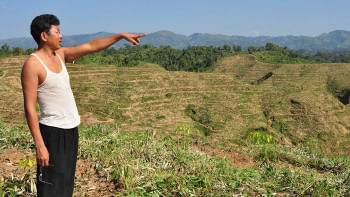Forest Department’s leadership crucial for conservation

Currently, the responsibility of conserving Bangladesh's biodiversity falls on two agencies under the Ministry of Environment, Forest and Climate Change (MoEFCC): the Forest Department and the Department of Environment (DoE). But I believe the government needs to give the leadership only to the Forest Department. Here's why.
First of all, the Forest Department is legally responsible for biodiversity, forests and wildlife conservation in Bangladesh, as per the Wildlife (Conservation and Security) Act, 2012 and its previous editions. In terms of strategic planning, this department, with the help of IUCN, finally drafted the National Conservation Strategy (NCS) in 2016, which was pending for almost 30 years. The MoEFCC made the NCS (2021-2036) public last year. Under the Strengthening Regional Cooperation for Wildlife Protection (SRCWP) project (2011-2016), consultants and implementing agencies drafted the Bangladesh Wildlife Conservation Master Plan (2015-2035) and conservation and management plans for vultures (2016-2025), gharials (2016-2025), and elephants (2018-2027). Other initiatives around the same time resulted in conservation plans for tigers (2018-2027) and dolphins (2020-2030) as well.
Along with the policy instruments, the Forest Department has the necessary organisational structure through its Wildlife and Nature Conservation Circle. The department is currently managing 53 protected areas including national parks, wildlife sanctuaries, marine protected areas (MPA), and eco-parks. Since 2012, the Wildlife Crime Control Unit (WCCU) has become an important part of the department. In these arrangements, we may question the sufficiency of manpower, capacity and funding, but their mandates are indeed unique.
At the ecosystem level, since 2003, the department has been a part of the USAID-funded co-management projects, namely the Nishorgo Support Project (2003-2008), the Integrated Protected Area Co-management (2008-2013), the Climate Resilient Ecosystems and Livelihoods (2013-2018), and the ongoing Ecosystems/Protibesh Activity (2021-2026). All these brought in people's participation in protected area management, which was further strengthened by the Protected Area Management Rules, 2017 enacted by the MoEFCC under the Wildlife Act.
If we now look into international biodiversity-related conventions, the Forest Department is the national focal point of the Convention on International Trade in Endangered Species of Wild Fauna and Flora (CITES), the Ramsar Convention's Programme on communication, capacity-building, education, participation and awareness (CEPA), and the Convention on the Conservation of Migratory Species of Wild Animals (CMS). On behalf of Bangladesh, the department regularly submits national reports to these conventions' secretariats.
But for some reasons, the DoE is the focal point of the Convention on Biological Diversity (CBD), the most important international agreement on biodiversity. As a result, the DoE formulated the last National Biodiversity Strategy and Action Plan (2016-2021), but apparently failed to contribute to its effective implementation. This department also prepares and submits Bangladesh's national reports to the CBD secretariat by engaging consultants and experts to collate required information.
One of the legal bases for the DoE to work on biodiversity conservation is the Bangladesh Environment Conservation Act, 1995 and its latest amendment in 2010. This act talks about declaring and managing ecologically critical areas (ECAs). This also resulted in the formulation of Ecologically Critical Area Management Rules, 2016. Nevertheless, these allow overlapping jurisdictions for conservation actions in biodiversity-rich areas, such as Cox's Bazar-Teknaf Peninsula (an ECA carrying several protected areas), Saint Martin's Island (an ECA and an MPA), and Tanguar Haor (an ECA and a Ramsar Site).
To streamline the MoEFCC's biodiversity conservation efforts, three urgent steps could be taken. First, in light of the latest Allocation of Business concerning the MoEFCC (March 2023), a new office order needs to be issued making the Forest Department the focal point of CBD. After being assigned, the department's first task should be formulation of a new NBSAP, preferably by 2024, in line with the Kunming-Montreal Global Biodiversity Framework. In the same vein, the Bangladesh Biodiversity Act, 2017 needs to be amended.
Second, the ongoing biodiversity conservation projects of the DoE should actively involve the Forest Department as a means of programmatic transition. Any pipeline project needs to be implemented by the Forest Department in association with the DoE. Building the capacity of the Wildlife and Nature Conservation Circle and expanding its geographical and technical coverage is crucial to adopt such a programmatic shift.
Finally, the Forest Department should further strengthen its leadership in biodiversity conservation by working on "conservation finance." By collaborating with relevant ministries and agencies, it should play a strong role in establishing the Biodiversity Conservation Fund, a provision created seven years back in the Bangladesh Biodiversity Act, 2017. The MoEFCC's 13-year-long experience of and learning from managing the Bangladesh Climate Change Trust Fund (BCCTF) should be useful in this regard. I wonder if the MoEFCC along with the Forest Department would take urgent steps to create this new fund as the government prepares for the next national budget.
Dr Haseeb Md Irfanullah is an independent consultant working on environment, climate change, and research systems. He is a visiting research fellow at the University of Liberal Arts Bangladesh (ULAB). He can be reached at [email protected]
Views expressed in this article are the author's own.
Follow The Daily Star Opinion on Facebook for the latest opinions, commentaries and analyses by experts and professionals. To contribute your article or letter to The Daily Star Opinion, see our guidelines for submission.

 For all latest news, follow The Daily Star's Google News channel.
For all latest news, follow The Daily Star's Google News channel. 










Comments